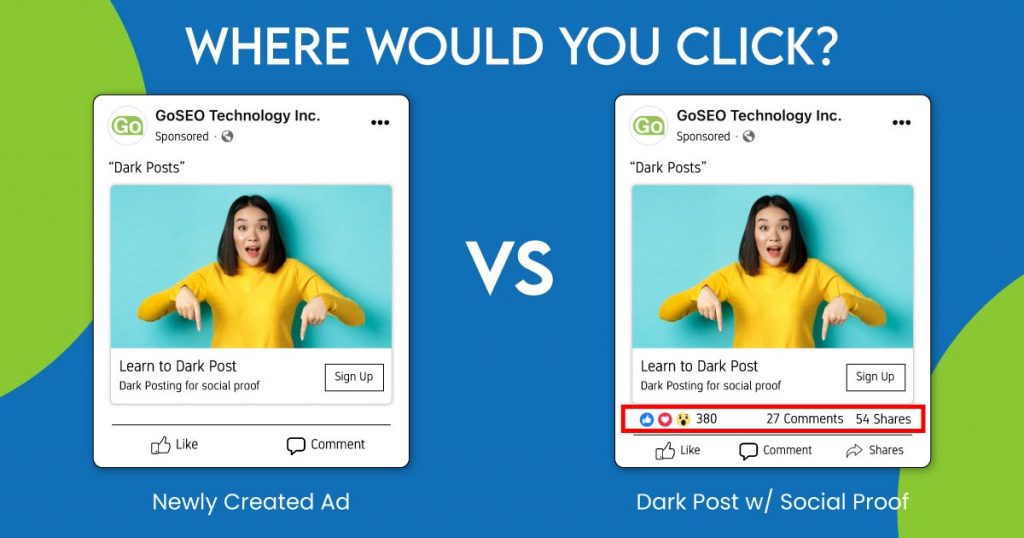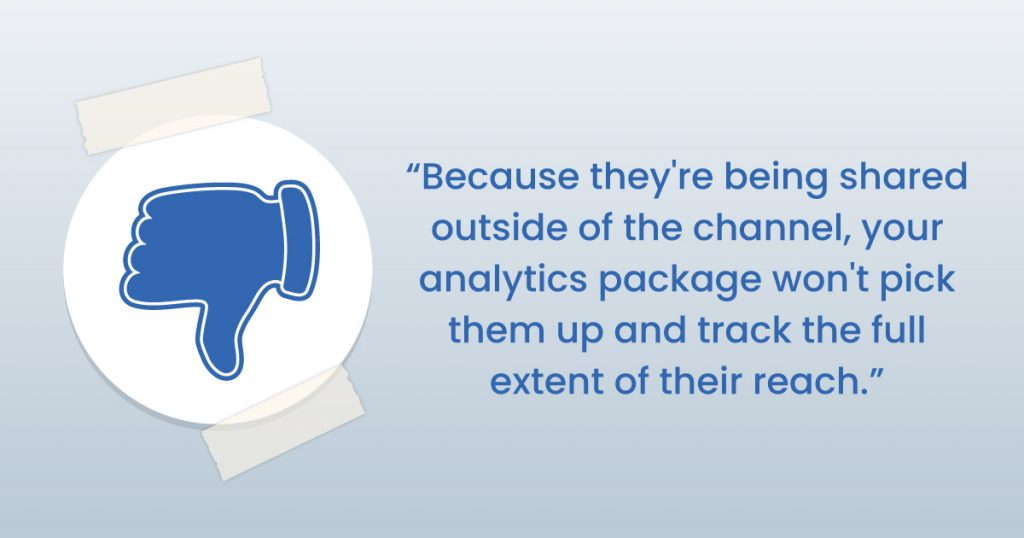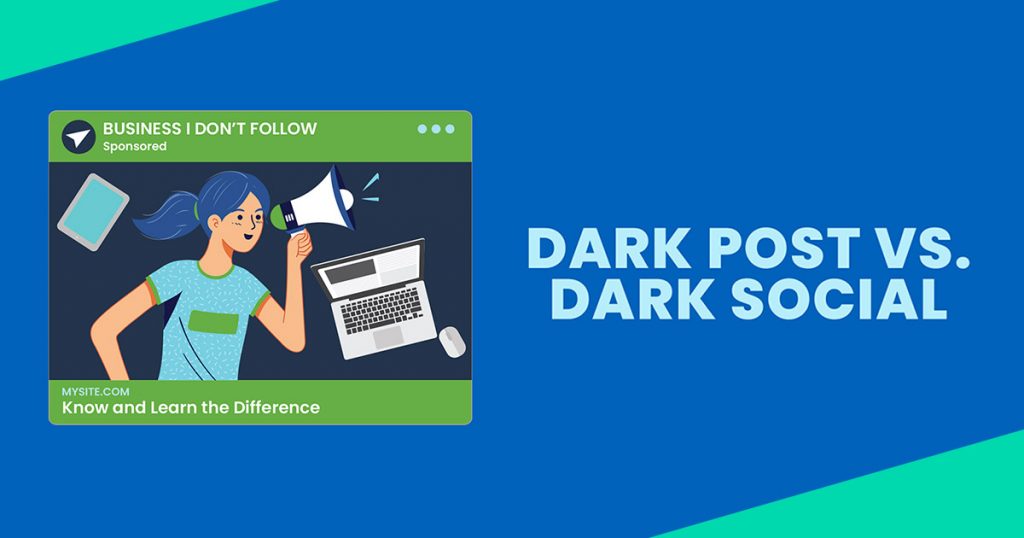Ever heard the curious buzzwords “dark post” and “dark social” thrown around an industry conference? Do you know what they are but aren’t sure how they affect your marketing efforts?
In this post, we’ll dispel the myths and offer insight into how these powerful digital tools can boost your advertising strategy. We’ll also provide a mini-guide as to when each should be utilized and examples of each in action.
What is a dark post?

The reasoning behind this is pretty straightforward: you want your post to be seen but don’t want it to be tracked as a “connection” between two accounts. The objective here is not branding or awareness but lead generation: you’re trying to get people to convert.
For example, if you were to create a post on Facebook, you would enter in the caption as if it were simply a Facebook update. It can be very effective in boosting web traffic because of how specific you can be with your targeting details.
If a brand were selling running shoes, they could create a post promoting an upcoming summer sale and target it to specific users who have shown interest in sports brands. In this way, the dark post can help avoid the awkwardness of brands blasting out generic posts to users with little to no connection to the brand itself and instead target more specific demographics.
One of the most common uses of “dark post” is in the political realm, where it refers to alternative versions of posts that reach different audiences on social media. This enables campaigns to test various messages on smaller portions of their audience and then broadcast what’s been deemed most successful to the rest.
In addition, dark posts can be used to create messages with only a select audience in mind. For example, you could make a video post that would only appear in front of users under 35 years old. It enables you to communicate with a targeted audience without losing the broader benefit of having your content shared far and wide.
The Trump campaign is an excellent example of dark posts in action. During the 2016 election, Donald Trump released a series of videos that targeted millennial voters, including one that featured his daughter speaking directly to them. He followed this up with a similar video that only showed up on Facebook feeds for millennials after midnight.
Another common use for dark posts is in the B2B marketing sphere. For example, Salesforce uses this tactic to promote events and sales on its social media channels. The company sets up an event page with a different photo and description on each channel and then publishes a simple message to only one account at launch. Then, when sales begin coming through the other channels, it can highlight elements of those pages that are most likely to land conversions.
Facebook was reportedly testing a new dark post feature in June 2017 to allow users to target specific groups of people based on their interests and demographics.
The upside of dark posts is that they provide much more precise targeting since you can get very specific about who sees your post. The downside is that the content may not spread as far as it would otherwise be if it were widely promoted.
What is a dark post?

Alexis Madrigal created the term “dark social” in 2012 to classify a type of social sharing that cannot be accounted for by a website’s analytics. It refers to sharing links on external sites, instant messaging, and email. He said that social marketers were actually getting and measuring the very tip of the iceberg.
For example, when a hospital signs up for a messaging service, you could send alerts about a new patient to everyone on that list. However, it’s also possible that some of these messages will go to the wrong list of recipients if your messaging service uses a shared email list. When this happens, you won’t track who saw the call to action.
Simply, dark social is a way to share content outside of the social media channel itself. Menacing as it sounds, it isn’t always a bad thing, especially if you’re using it as a way to supplement your social media presence.
The most common example of dark social is a group text messaging. If you’ve ever been part of a group message thread, you know that the messages don’t reach everyone on the list. For example, imagine sending out an invite to a party to your entire office. Only a few of your coworkers are likely going to see it, and it’ll get buried within a few hours.
On the other hand, if you send out the same message as part of your company’s announcement list or email marketing campaign, all of your coworkers are more likely to see it, and it’ll reach them faster. The key is using dark social to complement other types of social media. When the two combine forces, they’re much more effective than either could be separate.
What is the main difference between dark posts and dark social?
There’s a substantial difference between dark social and dark posts. Dark posts are genuinely “dark” since they’re only visible to certain segments of the audience you’ve targeted. They appear during a specific timeframe and then disappear from view entirely, so there’s no way to track their reach.
By contrast, dark social messages are any messages sent outside of a social media platform’s interface. They don’t have to disappear since they can be tracked the same way other messages get tracked. The only difference is that the traffic generated by dark social often goes unrecorded by analytics packages because they’re distributed outside of the framework.
Both dark social and dark posts can be used in almost any marketing scenario. Still, they’re most valuable when they’re combined with broader marketing efforts that include paid advertising as well.
Will it affect your brand if you use dark posts or dark social?
Using dark posts and dark social can be unsettling, especially if you’re not sure what the impact will be. For example, you could end up targeting an older demographic without realizing it. In general, it’s a good idea to remember that your followers are more important than their specific characteristics.
Let’s say that you have an audience that tends to skew toward millennials. It would be a mistake to use dark posts in an attempt to attract older users. Instead, you should focus on appealing directly to the millennial audience and using dark posts as an added benefit.
At the same time, you need to remember that your demographics and interests are changing over time. An older audience might not seem like a good prospect now, but it might become one in the future. As such, it’s good to keep your options open when you’re deciding where to place your social media content.
Conclusion
Get in Touch
Do you find this article helpful? For more information or questions, click the button to send us a message.
If you have any comments or suggestions, feel free to share them with us, too!

